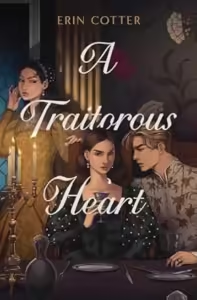A Traitorous Heart
Erin Cotter
Simon & Schuster
Published January 7, 2025
Amazon | Bookshop | Goodreads
About A Traitorous Heart
A noblewoman in the scandalous French court finds herself under the dangerous and watchful eye of the Parisian royalty when she falls in love with the handsome king who is betrothed to her former lover in this bisexual The Three Musketeers by way of Bridgerton and F.T. Lukens.
Paris, 1572. Seventeen-year-old Jacqueline “Jac” d’Argenson-Aunis is lady-in-waiting to her best friend and former lover, the French Princess Marguerite “Margot” de Valois, but she dreams of more. If Jac plays her cards right, one day, she’ll become a full member of the Societas Solis, a secret society of spies—just like her uncle and guardian, Viscount Gabriel d’Argenson-Aunis.
But it’s hard to think about her own ambitions while France is on the brink of war, and the only thing that might save the country is an alliance—a marriage between the Catholic Princess Margot and Henry, the awful son of the Huguenot queen. Who would be the perfect person to play matchmaker? Jac, of course.
Jac resents lying to her best friend almost as much as she resents the brazen and arrogant King Henry, but it’s her one chance to prove to the Societas Solis that she belongs among their ranks before her uncle can marry her off or worse. The more time Jac spends in the French Court’s clandestine corners, though, the more she starts to wonder if Henry is…not as terrible as she once believed. And the Societas Solis may not be what they seem.
Politics. Spies. Chaos in the French court. Perhaps even witchcraft? Everything’s more dangerous when love is involved.
My Review
I enjoyed this book, but it took me longer to read than I expected. I liked the main characters for the most part. Truthfully, I wanted to like Margot more than I did. I felt like the plot kind of easily dismissed her as selfish and frivolous, though there was obviously more to her. Her goal was to open a school where women and people of any class could be educated. So she obviously had a lot of depth.
I appreciated the development of the romance between Jac and Henry. At first, they don’t like each other at all, but as they’re forced to work together on a common goal, they each surprise the other, and gradually, they grow to like one another. I appreciated that the relationship developed more slowly, giving us time to savor it as it developed.
Jac’s complex relationship with her oncle also added some layers to her character and backstory. Sometimes she interpreted his behavior to mean pretty dramatic things, but I felt like that fit her character and her age. I appreciated that the story included some changes in their relationship and how they saw one another and understood what the other needed from them, if that makes sense.
All in all, I enjoyed this one, and I can see how the marketing comparisons to Bridgerton and F. T. Lukens fit. If those ideas appeal to you, I think you’d enjoy ]A Traitorous Heart.
Content Notes for A Traitorous Heart
Recommended for Ages 14 up.
Profanity/Crude Language Content
I don’t think there was much in the book in terms of profanity. Maybe some mild profanity infrequently.
Romance/Sexual Content
Kissing and references to sex.
Spiritual Content
Reference to religious differences between the Catholics and Huguenots (Protestants). References to spells, potions, and occult practices. Jac investigates a graverobbing group, looking for evidence of occult activity, possibly reanimating the dead.
Violent Content
Situations of peril. An assassin comes after Jac and her allies. After she ties him up, Jac tosses one would-be assassin over a wall into a moat. A fire consumes a building with a child inside. Jac attempts to save him and his cats. References to a prisoner potentially being tortured. (Not shown on scene.)
Drug Content
References to drinking alcohol at social gatherings. The King of France is consistently embarrassingly drunk at the events.
Note: This post contains affiliate links, which do not cost you anything to use but help support this blog. I received a free copy of this book in exchange for my honest review. All opinions are my own.
